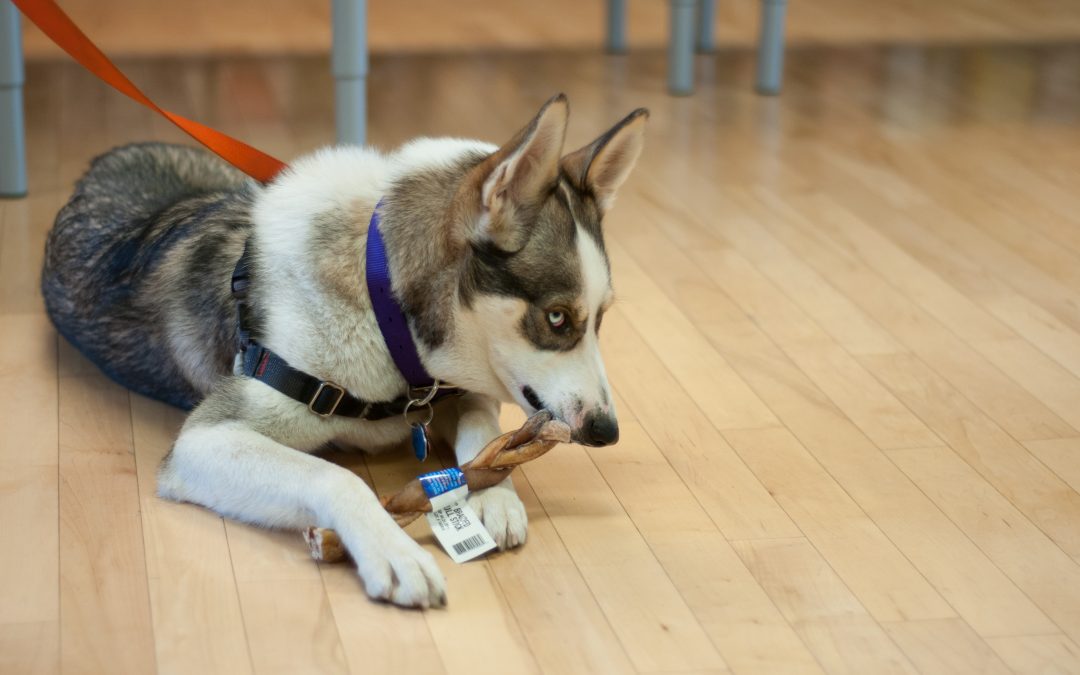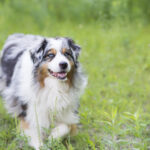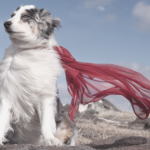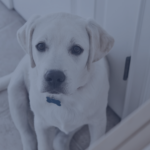As a veterinarian and dog trainer, I often get asked, “How can I stop my dog from snarling at me when he’s eating? It is so disrespectful. No matter how much I yell at him or take his food away when he does it, he still seems to forget that I’m the one who feeds him.” Luckily, disrespect isn’t part of the equation, even though it really looks and feels like it is. I can usually make a quick diagnosis: Resource Guarding. Thankfully, it’s a problem that is usually straightforward to address.
What is it?
Resource guarding is when dogs exhibit behaviors designed to prevent other animals (dogs, humans, cats, etc.) from obtaining something that is in their possession. They’ve got a thing they want to keep (the resource), so they do stuff (guarding) to make sure the other animals in the area don’t try to take it. Dogs most commonly will guard food, treats, toys, and locations. Sometimes they will also guard certain humans. Guarding is usually directed at other dogs (dog-dog), or humans (dog-human).
What does it look like?
Some guarding is quite obvious: growling, snarling, snapping, biting, lunging/chasing, or even taking an item away to hide. Some is more subtle: tense muscles/freezing, “hard eye” (staring), or eating food or treats faster than normal.
Why do dogs do it?
Because they evolved to want stuff!
It’s very important to understand that resource guarding can be a very normal behavior for dogs. The warnings that dogs give—growls, snarls, stares, freezing—are the dog trying to communicate politely, in dog language, that they would like you to back off. If you or the other dog listen to his request and back off, this is likely where the situation will end. It’s perfectly reasonable for a dog to say, “I’d rather keep this delicious snack to myself, thank you.”
If I had a $1000 bill in my hand, you would not fault me one bit for pulling it away from you as you reached towards it. I might even say, “Sorry, you can’t have that!” as I put it back in my pocket. Of course I want to keep my money. I need to pay my mortgage and feed my kids! A dog freezing, staring, growling, eating faster, or even snarling, is doing the same thing. He’s saying, “Hey, that’s mine! Please don’t take it!”
What should we do about it?
As with many behavior problems, there are three main ways to go on this one: acceptance, management, and training. In this case, the training would consist of desensitization and counter-conditioning.
Acceptance—or doing nothing—is appropriate when the guarding is mild, does not inconvenience or scare anyone, and NEVER involves injuries. For example, dog-dog guarding in which the dogs are “talking” but never injuring each other can usually be left alone. It’s like Animal Planet in your living room—just sit back and enjoy watching two animals talk in the language of their species!
Management alone is appropriate when there is minimal risk to humans or animals, and when the type of guarding allows for changing the environment to accommodate the guarder. For example, a dog who growls and practically inhales his food when other dogs are nearby can easily just be fed in another room with the door closed. He will most likely appreciate being able to eat in peace! A dog who growls at the owner when he approaches while the dog is working on a dental chewy can be put in his crate at chewy time and left alone until he is done. Management may also be used in more serious cases either while training is taking place, or if training is not feasible.
Training is appropriate when the guarding is more severe, results in injuries, or if it is inconvenient enough to the owner to make the time investment worthwhile. Training can also be done preventatively if the owner wishes (this is highly recommended for puppies!). Rather than focusing directly on changing the behavior (growling, biting, etc.), this training focuses on changing the dog’s emotional reaction to having his “stuff” taken from him. Instead of, “Oh crap! Here they come to take my food!” we want, “Oh boy! Here they come to take my food! Yayayayayay!!”
What should we NOT do?
Unfortunately it’s all too easy to make resource guarding worse. Punishing the warnings dogs give us, taking items away repeatedly with no reward, smacking or “alpha-rolling” dogs for guarding all actually make the guarding more serious. Dogs that are punished for guarding may stop giving the warning signs, but they still don’t want you to take their stuff. And if pushed too far, they are more likely to bite.
You see that I have $1000, and you ask me for it. I say ,“No way, that’s mine!” You grab it out of my hand and leave. Next payday, you ask for my money again. I yell at you, “NO! IT’S MINE AND YOU CAN’T HAVE IT!” You get right up in my face and yell, “DON’T YOU DARE YELL AT ME!” and then take my money and leave. Two weeks later, you walk up to me when I have my paycheck in my pocket. I don’t even wait for you to say anything, I just deliver a knock-out punch right to your nose. Whoops.
The second scenario is even worse. You take my money, then smack me or yell at me for protesting politely. I tend to be a pretty timid person, so the next 5 times you take my money, I’m silent. You think, “oh good, she learned to respect me,” but inside I’m getting more and more upset. The final time you take my money, I blow up, break your nose, and give you a concussion. Dogs can easily do the same thing when punished for objecting to their things being taken. They learn that they aren’t allowed to TELL you they are upset, but it doesn’t change the fact that they ARE upset, and they may eventually be pushed too far and end up biting you or someone else with no warning.
How does this desensitization and counter-conditioning stuff work?
Desensitization and counter-conditioning is all about starting where the dog is comfortable (a toy or object he really couldn’t care less about), and gradually teaching him to LOVE having his stuff taken by giving him even better stuff than whatever it was we took away. As he learns to love having his stuff taken, we very slowly increase the difficulty towards the stuff he really doesn’t want to give up.
Remember my $1000? What if, instead of you taking my whole $1000, you started out just taking a dollar, and then handing me $2 in return. The next time you see me, you take $5, and immediately hand me $10. You gradually take more and more, but each time you give me back twice as much. As I figure out the pattern, I start getting pretty happy when I see you approach. I might even try to get you to take my money.
That’s what we want with dogs. We want them to want us to take their stuff. And we get there by paying them handsomely for giving their stuff to us. It may take a while, especially if there’s a history of you taking my money with no reward. But if we work on it carefully and slowly enough, we can get there.
Hire a qualified trainer!
When working on sensitive issues like resource guarding, the devil is in the details. I highly recommend working with a qualified trainer for this problem. You’ll make progress much faster, and you’ll be less likely to get stuck or start going in the wrong direction. When hiring a trainer, be sure to ask about their methods and training education. You want someone who will train without pain, fear, or force, and ideally someone with a lot of high-quality education and experience. There is an excellent blog on finding a good trainer here, and you can search for an Academy for Dog Trainers graduate in your area here.
Cover photo credit: Jeannie Hutchins Photography
Second photo: iStock Credit Tepepa79
